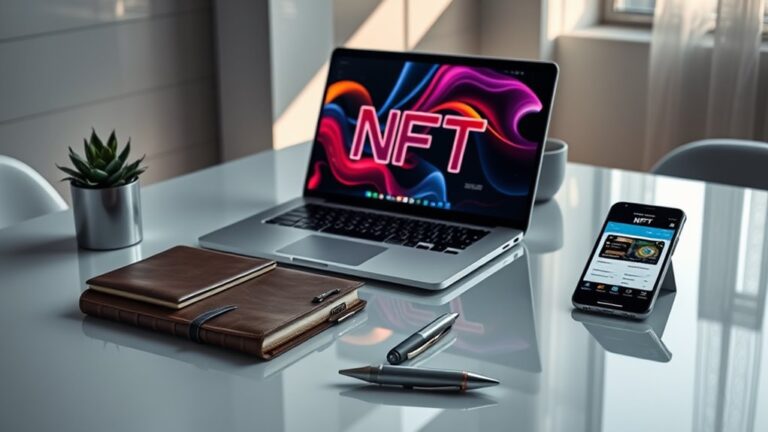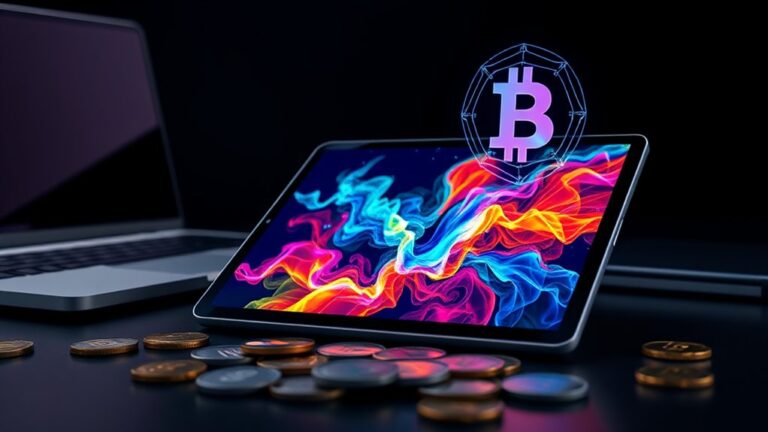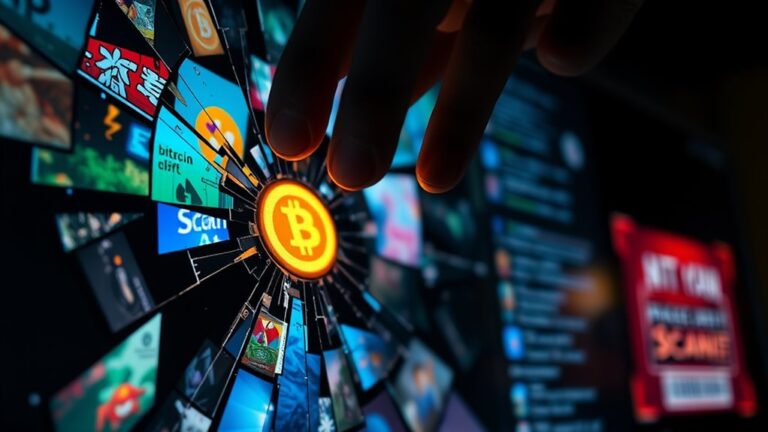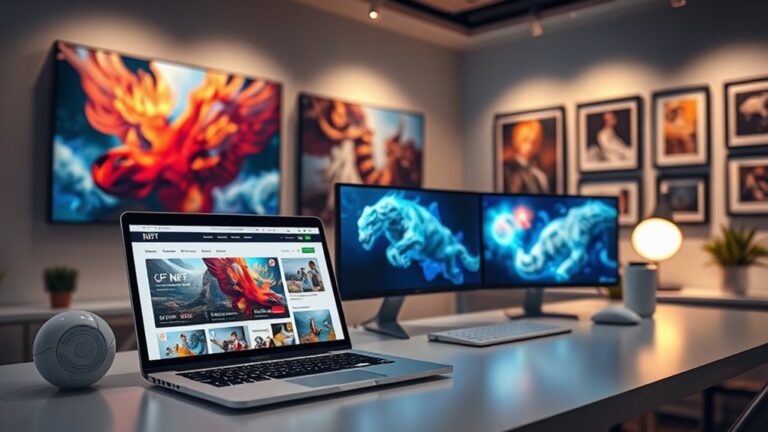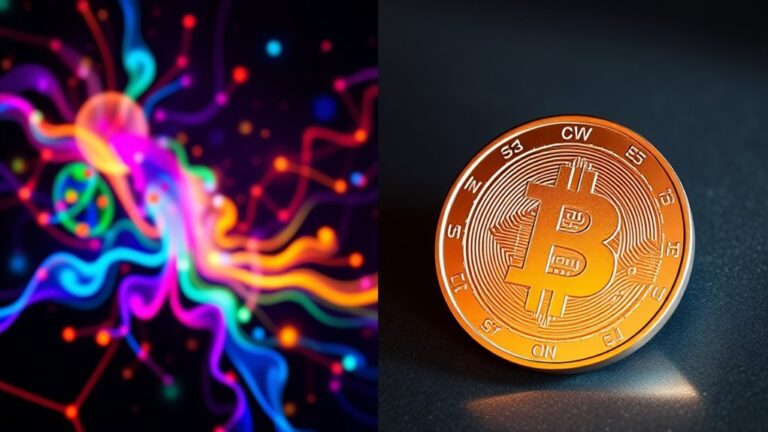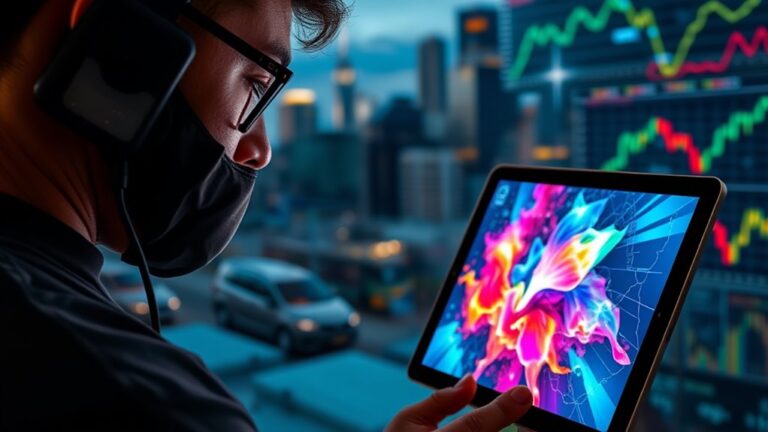
How Do NFTs Work: A Step-by-Step Guide
Non-Fungible Tokens, or NFTs, are unique digital assets that certify ownership and authenticity on the blockchain. Each NFT is distinct, leveraging blockchain technology for secure transactions and smart contracts for ownership transfer. The minting process converts digital items into NFTs, and a digital wallet is required for purchases. NFTs create new markets for artists and musicians while offering innovative use cases like virtual real estate. Exploring NFTs further will uncover more about their potential and future developments.
Key Takeaways
- NFTs are unique digital assets verified on a blockchain, ensuring ownership and authenticity of digital or real-world items.
- The minting process involves creating NFTs by selecting a blockchain, setting up a wallet, and recording ownership through smart contracts.
- To buy NFTs, set up a cryptocurrency wallet, link it to a marketplace, and understand associated transaction fees.
- Selling or trading NFTs requires listing them on platforms like OpenSea, considering pricing strategies, and engaging with communities for visibility.
- Future uses of NFTs include tokenizing art, music, and real estate, with a projected market growth towards utility-driven assets by 2030.
Understanding Non-Fungible Tokens (NFTs)
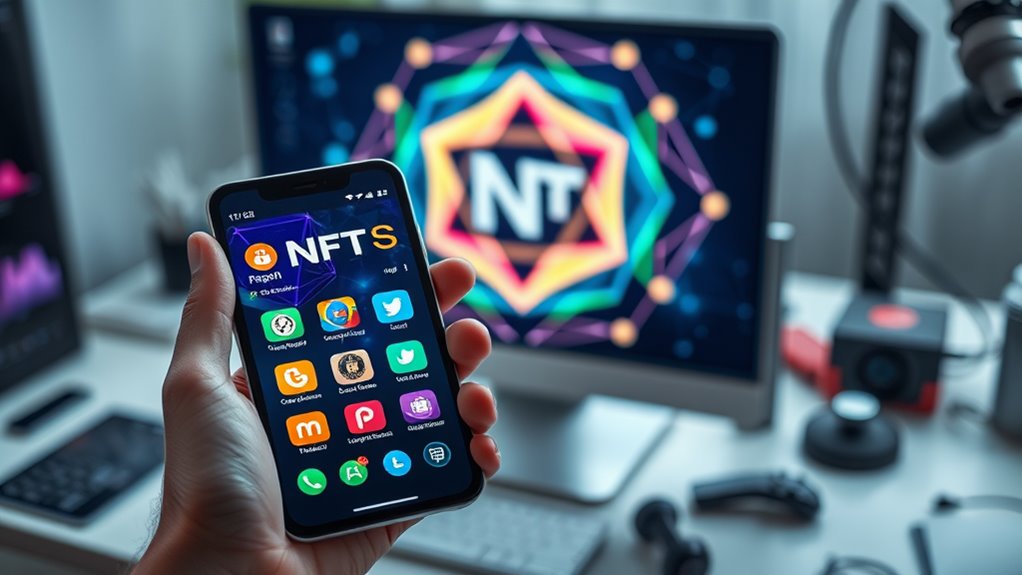
Non-fungible tokens, commonly known as NFTs, represent a significant innovation in the digital asset landscape. Unlike cryptocurrencies, which are interchangeable, NFTs are unique digital assets stored on blockchains. Each NFT certifies ownership and authenticity, making them ideal for representing both digital and real-world items, such as art and collectibles.
The use of blockchain technology guarantees secure and transparent transactions, while smart contracts facilitate ownership transfers. The creation process, known as minting, links an asset to a blockchain through encryption, assigning a unique identifier. The blockchain ensures the security of these transactions, making NFTs valuable for proving ownership and authenticity in various digital and real-world applications.
Various platforms, especially Ethereum, support NFT creation, but creators must own the intellectual property rights to the assets they mint. Overall, NFTs have transformed how digital ownership is perceived and managed.
Key Features of NFTs
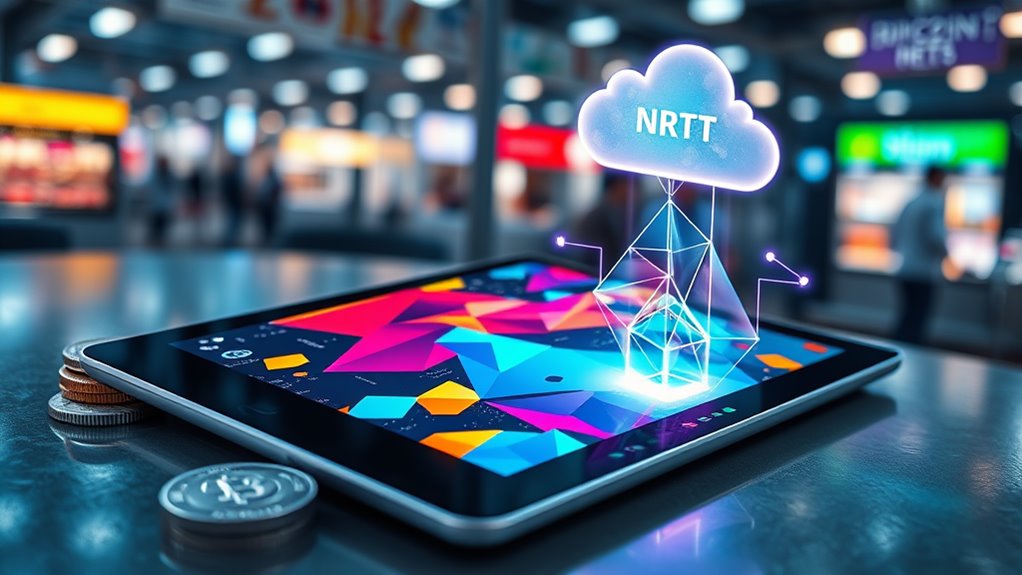
In the domain of digital assets, NFTs possess several key features that distinguish them from other token types. First, their uniqueness allows each NFT to represent a distinct asset, making them indivisible and non-fungible.
Ownership is verified through blockchain technology, ensuring a single owner, while authenticity is guaranteed, preventing falsification. Rarity plays a significant role in determining an NFT’s value, often influencing demand and pricing.
Additionally, NFTs exhibit interoperability, enabling their use across various platforms and blockchain networks, enhancing their versatility. Each NFT is defined by unique traits and metadata, which outline its properties, further contributing to its individuality. This fundamental difference from cryptocurrencies underscores the diverse applications of NFTs within the digital economy.
These features collectively make NFTs a notable innovation in the digital landscape.
The Minting Process Explained

The minting process is essential for creating NFTs, as it involves transforming unique digital assets into blockchain-based tokens.
This process encompasses several key aspects, including understanding intellectual property rights associated with the digital content and the gas fees required for transactions on various blockchains. Additionally, selecting a suitable blockchain is crucial for optimizing the minting experience and managing transaction costs effectively.
Understanding Minting Basics
Minting NFTs involves a systematic process that converts digital content into unique assets on a blockchain, establishing verifiable ownership and authenticity.
This process begins with selecting a blockchain platform such as Ethereum, Binance Smart Chain, or Solana, each offering distinct features and transaction costs.
Various types of digital content can be transformed into NFTs, including artwork, music, and videos.
To mint an NFT, a cryptocurrency wallet is necessary for managing assets and covering transaction fees.
The blockchain records ownership and metadata, ensuring a permanent and traceable history. Additionally, understanding market trends can enhance the success of your NFT sales.
Intellectual Property Considerations
Understanding intellectual property considerations is essential for anyone involved in the NFT minting process. NFTs do not automatically transfer underlying intellectual property rights, such as copyrights, unless explicitly agreed upon.
Creators must guarantee that the digital content selected for minting does not infringe on existing IP rights, as unauthorized reproductions can lead to legal issues. Additionally, trademark registrations may need expansion to cover NFT-related uses.
While smart contracts define ownership transfer and potential royalties, they do not extend to the underlying IP rights. Buyers typically receive limited ownership of the NFT itself without the associated rights, emphasizing the importance of clear agreements regarding commercial use and licensing terms. Understanding these factors can help prevent infringement and guarantee compliance. Moreover, creators should be aware of their potential tax obligations, as NFTs are often treated as property for tax purposes, which can influence the overall minting strategy.
Gas Fees Overview
Gas fees represent a significant aspect of the NFT minting process, influencing both creators and buyers in the blockchain environment.
These fees are transaction costs paid to miners for processing NFTs on networks like Ethereum. They serve to incentivize miners to verify transactions, ensuring network security.
However, high gas fees can substantially increase the cost of minting an NFT, potentially discouraging new creators. Fees fluctuate widely based on network congestion, meaning minting costs can range from $100 to $1,000.
Alternatives, such as Binance Smart Chain and Tezos, may offer lower fees. Some platforms support lazy minting, which allows creators to postpone costs until a sale occurs, providing a more affordable route for entering the NFT market. Additionally, the creation and transfer of NFTs contribute to substantial carbon emissions, highlighting the environmental impact of the minting process.
How to Buy NFTs
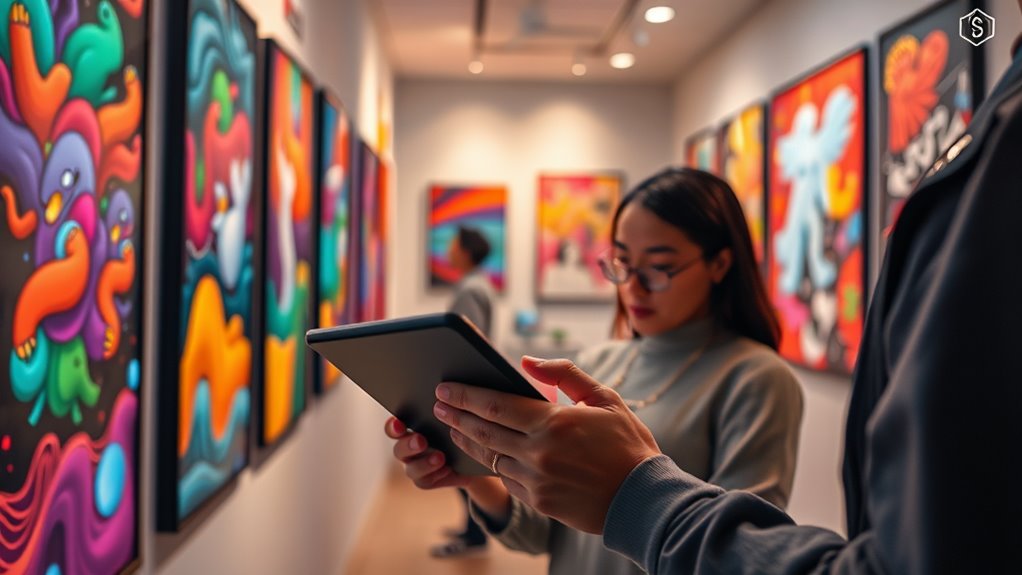
To buy NFTs, one must first choose a suitable marketplace, such as OpenSea or Rarible, which offer various digital assets. Next, setting up a cryptocurrency wallet, like MetaMask, is essential to store the necessary funds for transactions. Finally, after linking the wallet to the selected platform, the buyer can proceed to make their purchase, whether through a fixed price or bidding process. Additionally, exploring top NFT marketplaces can help buyers find unique digital collectibles that match their interests.
Choose a Marketplace
Selecting a marketplace is an essential step for anyone interested in buying NFTs, as it directly affects the overall experience and accessibility of digital assets.
Various platforms cater to different needs, making it vital to choose wisely. Here are some important considerations when selecting a marketplace:
- Fees and Charges: Understand the transaction and listing fees associated with each platform.
- Selection Variety: Some marketplaces specialize in specific types of NFTs, such as art or gaming assets.
- User Experience: A user-friendly interface can enhance the buying experience.
- Security Measures: Evaluate the security protocols in place to protect against fraud.
Additionally, be sure to connect your wallet to popular NFT marketplaces to streamline your buying process.
Set Up Wallet
Setting up a digital wallet is an essential step for anyone looking to buy non-fungible tokens (NFTs).
To begin, one must choose an Ethereum-compatible wallet, such as MetaMask, Trust Wallet, or Coinbase Wallet. After downloading the selected wallet extension, users can create a new wallet or import an existing one.
It is vital to store the seed phrase securely, using offline methods or encrypted password managers.
Adding funds requires purchasing Ethereum through platforms like Wire or Transact, or transferring from exchanges like Binance.
Finally, check that the wallet can connect to NFT marketplaces, ensuring it supports the relevant blockchain, to facilitate future transactions securely and efficiently. Additionally, consider security features when selecting a wallet to enhance the protection of your assets.
Make Your Purchase
Once a digital wallet has been successfully set up, the next step involves making a purchase on an NFT marketplace. Buyers should consider several factors when selecting a platform:
- Variety of Options: Choose from popular marketplaces like OpenSea or specialized platforms like NBA Top Shot.
- Security Features: Select a reputable marketplace to guarantee robust security measures.
- Compatibility: Verify that the platform supports the necessary blockchain and cryptocurrency.
- Fees and Charges: Be aware of transaction fees associated with each platform.
Once the appropriate marketplace is selected, buyers can browse NFTs, either purchasing at a fixed price or participating in auctions. Additionally, buying music NFTs allows fans to engage with artists and become part of the music ecosystem, enhancing their connection to the art form.
Following a purchase, ownership is recorded on the blockchain, solidifying the buyer’s rights.
Selling and Trading NFTs
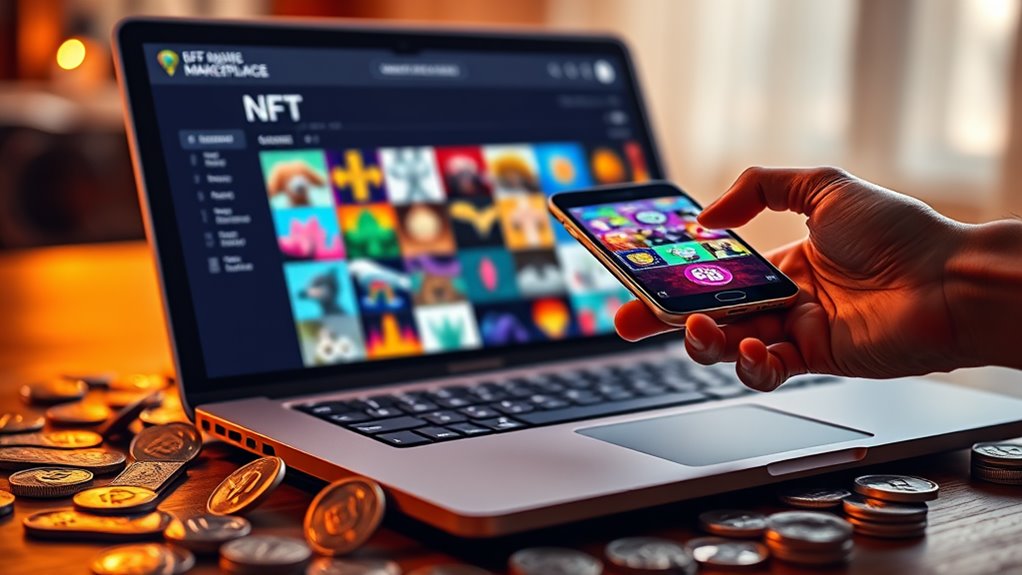
Selling and trading NFTs involve a series of strategic decisions that can greatly impact the success of a digital asset. Sellers can choose to list their NFTs on various platforms, such as OpenSea or Rarible, each with unique fees and minting processes.
The creation of an NFT, known as minting, converts a digital item into a blockchain asset. Pricing strategies can vary, with options for fixed prices or auctions. Sellers must also consider transaction costs, or gas fees, associated with blockchain operations.
Engaging with communities and utilizing effective marketing can enhance visibility. Additionally, setting royalties guarantees creators receive a percentage from future sales, fostering ongoing income from their digital creations.
Use Cases for NFTs

The versatility of NFTs extends far beyond selling and trading, as they have established a wide range of practical applications across various industries.
NFTs are revolutionizing industries with diverse applications that go beyond mere trading, showcasing their practical value and innovation.
Significantly, NFTs play important roles in sectors such as art, music, real estate, identity verification, and decentralized finance.
Key use cases include:
- Artists tokenize digital creations, ensuring uniqueness and enabling royalties through smart contracts.
- Musicians sell music and concert tickets directly to fans, improving royalty transparency.
- Virtual real estate transactions are securely recorded on the blockchain, allowing ownership benefits.
- NFTs serve as secure digital identity proofs, reducing identity theft risks.
These applications highlight how NFTs are reshaping traditional practices, offering innovative solutions and fostering new business models across diverse fields.
The Future of NFTs in the Crypto Space

How will NFTs evolve within the rapidly changing crypto landscape? The future of NFTs appears promising as they shift from mere collectibles to utility-driven assets.
With the NFT market projected to reach US$152.54 billion by 2030, innovations like utility NFTs and real-world asset tokenization are reshaping the ecosystem.
Bitcoin’s entrance into the NFT space introduces enhanced security, while hybrid NFTs combine digital and physical elements, increasing their appeal.
As decentralized finance (DeFi) integrates with NFTs, user engagement is expected to grow.
Additionally, established projects are expanding into infrastructure, fostering community involvement through native tokens.
Frequently Asked Questions
Can NFTS Be Used for Physical Assets Like Real Estate?
NFTs can indeed be utilized for physical assets such as real estate. They facilitate secure ownership, enable fractional investments, and streamline transactions, thereby expanding accessibility while ensuring transparency and reducing the risk of fraud.
What Is the Environmental Impact of Minting NFTS?
As the saying goes, “You can’t make an omelet without breaking eggs.” Minting NFTs considerably impacts the environment, consuming vast energy, generating e-waste, and contributing to carbon emissions, necessitating sustainable practices for future viability.
How Do Royalties Work for NFT Creators?
NFT royalties allow creators to earn a percentage from secondary sales, typically embedded in smart contracts. This system guarantees automated payments, providing ongoing income and incentivizing quality work while facing challenges in marketplace consistency and legal enforcement.
Can NFTS Lose Value Over Time?
NFTs can indeed lose value over time due to factors like market saturation, economic conditions, and speculative buying. Variability in demand and the volatility of cryptocurrencies also greatly contribute to potential declines in value.
Are There Risks Involved in Investing in NFTS?
“All that glitters is not gold.” Investing in NFTs carries risks such as market volatility, regulatory uncertainty, technological vulnerabilities, and potential fraud. Awareness of these factors is essential for informed decision-making in this evolving landscape.
Conclusion
In summary, non-fungible tokens (NFTs) represent a significant innovation in the digital landscape, transforming the way ownership and value are perceived. As unique digital assets, they have opened new avenues for artists, collectors, and investors. The journey from minting to trading illustrates the intricate web of technology and creativity that underlies NFTs. As the crypto space evolves, NFTs are poised to shape future interactions in the digital domain, much like a seed growing into a diverse and vibrant ecosystem.

